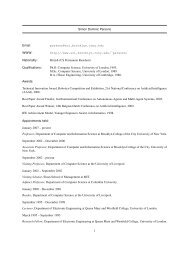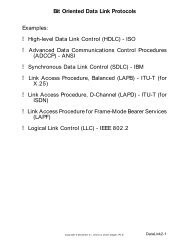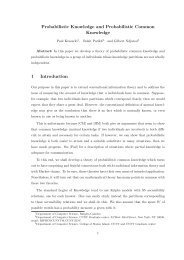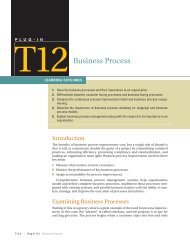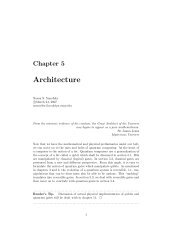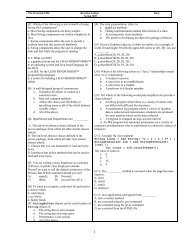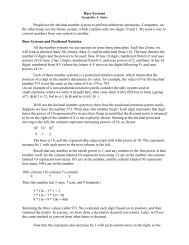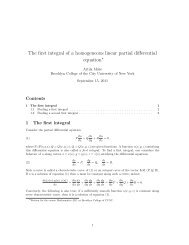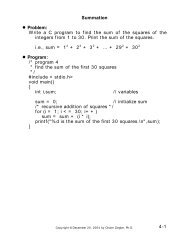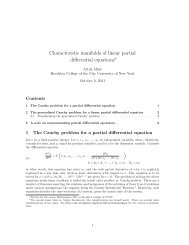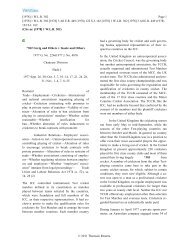Supplemental notes on gear ratios, torque and speed
Supplemental notes on gear ratios, torque and speed
Supplemental notes on gear ratios, torque and speed
You also want an ePaper? Increase the reach of your titles
YUMPU automatically turns print PDFs into web optimized ePapers that Google loves.
CORC 3303 – Exploring Robotics<br />
Joel Kammet<br />
Vocabulary<br />
<str<strong>on</strong>g>Supplemental</str<strong>on</strong>g> <str<strong>on</strong>g>notes</str<strong>on</strong>g> <strong>on</strong> <strong>gear</strong> <strong>ratios</strong>, <strong>torque</strong> <strong>and</strong> <strong>speed</strong><br />
SI (Système Internati<strong>on</strong>al d'Unités) – the metric system<br />
force<br />
<strong>torque</strong><br />
axis<br />
moment arm<br />
accelerati<strong>on</strong><br />
<strong>gear</strong> ratio<br />
newt<strong>on</strong> – Si unit of force<br />
meter – SI unit of distance<br />
newt<strong>on</strong>-meter – SI unit of <strong>torque</strong><br />
Torque<br />
Torque is a measure of the tendency of a force to rotate an object about some axis. A <strong>torque</strong> is<br />
meaningful <strong>on</strong>ly in relati<strong>on</strong> to a particular axis, so we speak of the <strong>torque</strong> about the motor shaft, the<br />
<strong>torque</strong> about the axle, <strong>and</strong> so <strong>on</strong>. In order to produce <strong>torque</strong>, the force must act at some distance from<br />
the axis or pivot point. For example, a force applied at the end of a wrench h<strong>and</strong>le to turn a nut around<br />
a screw located in the jaw at the other end of the wrench produces a <strong>torque</strong> about the screw. Similarly,<br />
a force applied at the circumference of a <strong>gear</strong> attached to an axle produces a <strong>torque</strong> about the axle. The<br />
perpendicular distance d from the line of force to the axis is called the moment arm.<br />
In the following diagram, the circle represents a <strong>gear</strong> of radius d. The dot in the center represents the<br />
axle (A). A force F is applied at the edge of the <strong>gear</strong>, tangentially.<br />
F<br />
A<br />
d<br />
Diagram 1<br />
In this example, the radius of the <strong>gear</strong> is the moment arm. The force is acting al<strong>on</strong>g a tangent to the<br />
<strong>gear</strong>, so it is perpendicular to the radius. The amount of <strong>torque</strong> at A about the <strong>gear</strong> axle is defined as<br />
= F×d<br />
1
We use the Greek letter Tau ( ) to represent <strong>torque</strong>. The SI (metric) unit of force is the newt<strong>on</strong>, <strong>and</strong><br />
the unit of distance is meters. Since <strong>torque</strong> is the product of force times distance, the unit of <strong>torque</strong> is<br />
newt<strong>on</strong>-meters. (Do NOT read this as newt<strong>on</strong>s per meter, which would indicate divisi<strong>on</strong>, but the<br />
hyphenated term newt<strong>on</strong>-meters, or better still, newt<strong>on</strong>·meters, indicating that it is a product.)<br />
So, given a force <strong>and</strong> a moment arm (distance), we can use the above formula to compute the resulting<br />
<strong>torque</strong>. For example, referring to Diagram 1, if we are given that the force F is 20 newt<strong>on</strong>s <strong>and</strong> the<br />
radius d is 3 centimeters (0.03 meters), we can calculate the <strong>torque</strong> about the axle as<br />
=20 newt<strong>on</strong>s×0.03meters=0.6 newt<strong>on</strong>⋅meters<br />
C<strong>on</strong>versely, if we already know the <strong>torque</strong> acting about the axle of a wheel <strong>and</strong> we know the radius, we<br />
can calculate the force that is applied al<strong>on</strong>g a tangent to the edge of the wheel by dividing the <strong>torque</strong> by<br />
the moment arm. This is useful because it enables us to determine the horiz<strong>on</strong>tal force that the wheel<br />
applies to the floor, pushing the robot forward.<br />
F = d<br />
For example, referring again to Diagram 1, if we know that a <strong>torque</strong> of 0.54 newt<strong>on</strong>-meters is applied<br />
by a motor about the axle at A, <strong>and</strong> that the radius d is 3 centimeters, then we can calculate the force<br />
applied at the edge, tangential to the wheel or <strong>gear</strong>, as<br />
F = 0.54newt<strong>on</strong>⋅meters =18newt<strong>on</strong>s<br />
0.03meters<br />
Accelerati<strong>on</strong><br />
Why is it useful to know the force applied at the edge of a wheel? Because it gives us informati<strong>on</strong><br />
about how rapidly the wheel (<strong>and</strong> the vehicle or robot attached to the wheel) will accelerate. Newt<strong>on</strong>'s<br />
Sec<strong>on</strong>d Law states that the accelerati<strong>on</strong> of an object is directly proporti<strong>on</strong>al to the net force acting <strong>on</strong> it,<br />
<strong>and</strong> inversely proporti<strong>on</strong>al to its mass. This can be expressed by the equati<strong>on</strong><br />
a= F m<br />
The greater the force, the faster the object will accelerate. If we double the force, the rate of<br />
accelerati<strong>on</strong> doubles, <strong>and</strong> so <strong>on</strong>.<br />
Cauti<strong>on</strong>: Accelerati<strong>on</strong> is not the same thing as <strong>speed</strong>. Accelerati<strong>on</strong> is the rate of change of <strong>speed</strong>. It is<br />
the rate at which the <strong>speed</strong> of an object increases. Negative accelerati<strong>on</strong> (decelerati<strong>on</strong>) is the rate at<br />
which the <strong>speed</strong> of an object decreases. In the metric system, a comm<strong>on</strong> unit of <strong>speed</strong> is<br />
kilometers/sec<strong>on</strong>d. Accordingly, the unit of accelerati<strong>on</strong> is kilometers/sec<strong>on</strong>d/sec<strong>on</strong>d or km/sec 2 . Read<br />
that as “kilometers per sec<strong>on</strong>d squared”.<br />
Note that this does NOT tell us how fast the object will move; it does let us determine how quickly the<br />
object gets up to a particular <strong>speed</strong>.<br />
2
Gear Ratios <strong>and</strong> Torque<br />
When a series of <strong>gear</strong>s is used to transmit power from a motor to a wheel, the <strong>gear</strong> c<strong>on</strong>nected to the<br />
motor is called the driver or input <strong>gear</strong>, <strong>and</strong> the <strong>gear</strong> c<strong>on</strong>nected to the wheel is called the driven or<br />
output <strong>gear</strong>. In general, <strong>gear</strong>s situated in between the driver <strong>and</strong> the driven <strong>gear</strong>s are called idler <strong>gear</strong>s.<br />
The <strong>gear</strong> ratio is the ratio of the number of teeth <strong>on</strong> the output <strong>gear</strong> (the <strong>on</strong>e c<strong>on</strong>nected to the wheel)<br />
to the number of teeth <strong>on</strong> the input <strong>gear</strong> (c<strong>on</strong>nected to the motor).<br />
Remember -- the <strong>gear</strong> ratio is the ratio of<br />
output : input (read this as "output to input")<br />
driven : driver (read as "driven to driver")<br />
Since a ratio is just another way to express a fracti<strong>on</strong>, we can also write the <strong>gear</strong> ratio as:<br />
GR= Output<br />
Input = Driven<br />
Driver<br />
Equivalently, it is the ratio of the circumference of the output <strong>gear</strong> to the circumference of the input<br />
<strong>gear</strong>, because the number of teeth <strong>on</strong> each <strong>gear</strong> is proporti<strong>on</strong>al to the <strong>gear</strong>'s circumference C. Also,<br />
since the formula for circumference is C= D <strong>and</strong> diameter (D) is twice the radius (R) we can write<br />
GR= D o<br />
D i<br />
= D o<br />
D i<br />
= 2R o<br />
2R i<br />
= R o<br />
R i<br />
(The subscripts o <strong>and</strong> i refer to the output <strong>and</strong> input <strong>gear</strong>s respectively.)<br />
The <strong>gear</strong> ratio expresses the ratio of the output <strong>torque</strong> to the input <strong>torque</strong>. Thus, we can multiply the<br />
<strong>torque</strong> supplied at the motor shaft (the input) by the <strong>gear</strong> ratio to find the <strong>torque</strong> at the wheel axle (the<br />
output).<br />
We can calculate the <strong>torque</strong> at the wheel axle as follows:<br />
WheelTorque=MotorTorque× OutputSize<br />
InputSize<br />
or more simply:<br />
WheelTorque=MotorTorque×GR<br />
For example, if the <strong>torque</strong> about the motor shaft is 8 newt<strong>on</strong>s (newt<strong>on</strong> is the metric unit for <strong>torque</strong>), the<br />
<strong>gear</strong> attached to the motor shaft has 16 teeth <strong>and</strong> the <strong>gear</strong> attached to the wheel axle has 48 teeth, the<br />
<strong>torque</strong> at the wheel axle is<br />
WheelTorque=8 newt<strong>on</strong>s× 48 =24 newt<strong>on</strong>s<br />
16<br />
3
That's fine if we know the <strong>torque</strong> at the motor shaft <strong>and</strong> want to find out the <strong>torque</strong> at the wheel axle.<br />
What if we know the <strong>torque</strong> at the wheel axle <strong>and</strong> want to find out the <strong>torque</strong> at the motor shaft? We<br />
can multiply both sides of the equati<strong>on</strong> by the RECIPROCAL of the <strong>gear</strong> ratio:<br />
InputSize<br />
OutputSize ×WheelTorque=MotorTorque×OutputSize InputSize × InputSize<br />
OutputSize<br />
Then, cancelling terms <strong>and</strong> exchanging the right <strong>and</strong> left sides of the equati<strong>on</strong> gives us:<br />
MotorTorque=WheelTorque× InputSize<br />
OutputSize<br />
Gear Ratios <strong>and</strong> Speed<br />
Transmitting power through a series of <strong>gear</strong>s can also affect rotati<strong>on</strong>al <strong>speed</strong>. In a system c<strong>on</strong>sisting of<br />
<strong>on</strong>ly two <strong>gear</strong>s, as they revolve each tooth of the input (driver) <strong>gear</strong> meshes with, <strong>and</strong> pushes, a tooth of<br />
the output (driven) <strong>gear</strong>. If the input <strong>gear</strong> has fewer teeth than the output <strong>gear</strong>, then the input <strong>gear</strong> will<br />
turn through a complete revoluti<strong>on</strong> so<strong>on</strong>er than the output <strong>gear</strong>. The output <strong>gear</strong> will rotate more<br />
slowly than the input. This is called <strong>gear</strong>ing down. If the input <strong>gear</strong> has exactly half as many teeth as<br />
the output <strong>gear</strong>, the input <strong>gear</strong> will turn completely around in the same amount of time that the output<br />
<strong>gear</strong> takes to turn <strong>on</strong>ly half-way, so the output <strong>gear</strong> will rotate at half the <strong>speed</strong> of the input. Here is an<br />
illustrati<strong>on</strong> of <strong>gear</strong>ing down.<br />
On the other h<strong>and</strong>, if the input <strong>gear</strong> has more teeth than the output, the opposite occurs. In this case the<br />
output <strong>gear</strong> will rotate more quickly than the input. This is called <strong>gear</strong>ing up. If the input <strong>gear</strong> has<br />
twice as many teeth as the output, the input <strong>gear</strong> will turn <strong>on</strong>ly half-way around in the time it takes for<br />
the output to turn completely around, so the output <strong>gear</strong> will rotate at twice the <strong>speed</strong> of the input. Here<br />
is an illustrati<strong>on</strong> of <strong>gear</strong>ing up.<br />
Given the number of teeth <strong>on</strong> both <strong>gear</strong>s, if we know the rotati<strong>on</strong>al <strong>speed</strong> of the input <strong>gear</strong>, we can<br />
calculate the rotati<strong>on</strong>al <strong>speed</strong> of the output <strong>gear</strong> as follows:<br />
OutputSpeed =InputSpeed × InputSize<br />
OutputSize<br />
4
Since the input <strong>gear</strong> is c<strong>on</strong>nected directly to the motor shaft, it turns at the same rotati<strong>on</strong>al <strong>speed</strong> as the<br />
motor. Similarly, the output <strong>gear</strong> is c<strong>on</strong>nected directly (through the axle) to the wheel, so the wheel<br />
revolves at the same rotati<strong>on</strong>al <strong>speed</strong> as the output <strong>gear</strong>.<br />
For example, if the motor rotates at 300 RPM, which means 300 revoluti<strong>on</strong>s per minute (300 rev/min),<br />
the input <strong>gear</strong> has 8 teeth <strong>and</strong> the output <strong>gear</strong> has 24 teeth (this is <strong>gear</strong>ing down), the rotati<strong>on</strong>al <strong>speed</strong> of<br />
the wheel can be determined as follows:<br />
OutputRPM =300 rev<br />
min × 8 rev<br />
=100<br />
24 min<br />
On the other h<strong>and</strong>, if the motor rotates at 300 RPM, the input <strong>gear</strong> has 24 teeth <strong>and</strong> the output <strong>gear</strong> has<br />
8 teeth (this is <strong>gear</strong>ing up), the rotati<strong>on</strong>al <strong>speed</strong> of the wheel will be:<br />
OutputRPM =300 rev<br />
min × 24 rev<br />
=900<br />
8 min<br />
If there are <strong>on</strong>e or more additi<strong>on</strong>al (idler) <strong>gear</strong>s between the input <strong>and</strong> output <strong>gear</strong>s, they can be<br />
disregarded in determining the final <strong>speed</strong>. It is sufficient to c<strong>on</strong>sider the relative sizes (or numbers of<br />
teeth) of the input <strong>and</strong> output <strong>gear</strong>s.<br />
Note that the up <strong>and</strong> down in <strong>gear</strong>ing up <strong>and</strong> <strong>gear</strong>ing down refers to the rotati<strong>on</strong>al <strong>speed</strong>, NOT <strong>torque</strong>.<br />
It is important to recognize that the fracti<strong>on</strong> in the above equati<strong>on</strong> (InputSize/OutputSize) is the inverse<br />
of the <strong>gear</strong> ratio, <strong>and</strong> so the effect of <strong>gear</strong>ing <strong>on</strong> <strong>speed</strong> is the inverse of its effect <strong>on</strong> <strong>torque</strong>. That is, if<br />
as a result of the <strong>gear</strong> arrangement the <strong>torque</strong> increases, the rotati<strong>on</strong>al <strong>speed</strong> decreases. And if the<br />
<strong>torque</strong> decreases, the rotati<strong>on</strong>al <strong>speed</strong> increases.<br />
Also, note that all references to <strong>speed</strong> in this secti<strong>on</strong> about <strong>gear</strong>ing have been about rotati<strong>on</strong>al <strong>speed</strong>.<br />
This is the rate, in revoluti<strong>on</strong>s/minute, at which the comp<strong>on</strong>ents – wheels, <strong>gear</strong>s, etc. -- rotate about<br />
their axes, <strong>and</strong> NOT the <strong>speed</strong> at which the robot travels al<strong>on</strong>g the floor.<br />
Wheels <strong>and</strong> Speed<br />
This final secti<strong>on</strong> will review how the wheel size affects the maximum <strong>speed</strong> at which the robot travels.<br />
Notice that term maximum. That is the maximum <strong>speed</strong> at which the robot will move al<strong>on</strong>g the floor.<br />
It assumes that there is sufficient <strong>torque</strong> to overcome the fricti<strong>on</strong>al forces that impede moti<strong>on</strong>. This<br />
secti<strong>on</strong> does not address the questi<strong>on</strong> of how l<strong>on</strong>g it takes to accelerate the robot up to its maximum<br />
<strong>speed</strong>, or even if it can do so at all. That depends up<strong>on</strong> the force applied by the wheel horiz<strong>on</strong>tally<br />
al<strong>on</strong>g the floor, which in turn depends <strong>on</strong> the wheel size <strong>and</strong> the <strong>torque</strong> at the wheel axle, which in turn<br />
depends <strong>on</strong> the <strong>gear</strong>ing <strong>and</strong> the amount of <strong>torque</strong> that the motor can produce. Here, we simply assume<br />
that the wheel has gotten up to “full <strong>speed</strong>”.<br />
This calculati<strong>on</strong> is simple. Remember that the circumference of the wheel is given by C= d .<br />
As the wheel rotates al<strong>on</strong>g the floor, every point <strong>on</strong> the circumference of the wheel c<strong>on</strong>tacts a<br />
corresp<strong>on</strong>ding point <strong>on</strong> the floor. Imagine that you mark the point <strong>on</strong> a wheel that is in c<strong>on</strong>tact with the<br />
floor, also marking the floor at that point, then roll the wheel in a straight line until the original point is<br />
in c<strong>on</strong>tact with the floor again, <strong>and</strong> mark the floor again at that point. It is easy to see that the distance<br />
5
etween the two marks <strong>on</strong> the floor will be equal to the circumference of the wheel. Therefore we have<br />
an easy way to determine the distance that the robot travels for each rotati<strong>on</strong> of its wheel: it is simply<br />
the circumference of the wheel. If we multiply the distance the robot travels during EACH rotati<strong>on</strong><br />
times the number of rotati<strong>on</strong>s per minute, we will know the distance travelled per minute. Therefore,<br />
the <strong>speed</strong> that the robot travels is the product of the circumference of its drive wheels (the wheels that<br />
are applying power to the floor) times the rotati<strong>on</strong>al <strong>speed</strong> of the wheels. In other words:<br />
v=C×<br />
In this equati<strong>on</strong>, v represents the linear velocity (<strong>speed</strong>), C represents the circumference of the wheel,<br />
<strong>and</strong> ω (the Greek letter omega) represents the rotati<strong>on</strong>al <strong>speed</strong>.<br />
For example, if a robot's drive wheel is 4 centimeters (4 cm) in diameter <strong>and</strong> it is rotating at 900 RPM<br />
(900 rev/min), the circumference of the wheel is<br />
C= d=3.14×4cm=12.56cm<br />
<strong>and</strong> the robot will travel al<strong>on</strong>g the floor at a <strong>speed</strong> of<br />
v=C×=12.56cm×900 rev cm<br />
=11304<br />
min min<br />
We can translate this into more c<strong>on</strong>venient units: 4 cm = 0.04 m <strong>and</strong> 900 rev/min = 15 rev/sec so<br />
v=C×=×0.04 m×15 rev<br />
sec =1.884 m<br />
sec<br />
6



